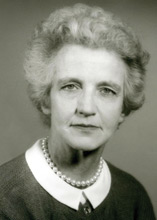letters
 Mary S. Goodwin, MD
Mary S. Goodwin, MDAutism and Reading
I read with interest Susan Conova’s piece, “For Kids with Autism, Learning to Talk Starts with Reading” (Spring 2013 issue), an article which embraces new hope for the treatment of autism (now widened to “autism spectrum disorders”), as exemplified by the studies of Dr. Marion Blank. Readers might be interested to go back to 1961 at Cooperstown’s Mary Imogene Bassett Hospital, where a new approach to treatment of autism centered around the studies of Associate Pediatrician Mary S. Goodwin, MD (pictured at right), utilizing the “Edison Responsive Environment,” a computerized electric typewriter also called the “Talking Typewriter.” Dr. Goodwin was one of the pioneers in the use of this technology, and it was the first time it had been installed in a hospital. The equipment was “designed to create an environment where learning to read would be a successful, enjoyable experience for the student by allowing him to explore, discover relationships, progress at his own speed, and receive feedback.” (Sanderson, et al., document from American Institutes for Research in the Behavioral Sciences, Palo Alto, Calif., 1972.) Widely publicized in the New York Times and other popular media, Dr. Goodwin’s studies were apparently never published, but as described later by Grace Kull, one of Dr. Goodwin’s assistants, “A magazine is going to have an article about ERE and a picture of Eddie, one of the autistic kids who came to Bassett Hall to use it. We had that article in the New York Times and everyone is picking it up. NBC or CBS is coming up to see Bassett Hall about doing a TV story.” (Mrs. Kull’s reflections on the machine are taken from “Dear Bert. Selected Letters 1958-1968,” Xoxox Press.) To fast forward more than half a century, treatment paradigms for autism continue to be a work in process—and, hopefully, progress.
John S. Davis, MD
Clinical Professor Emeritus of Medicine
Bassett Medical Center
Editor’s Note: Dr. Davis is working on a book on Bassett’s history. He is still accepting comments and vignettes from P&S alumni and faculty who spent time in Cooperstown: davi7js4@hughes.net.
Prostate Cancer
A correction for your cover (Spring 2013 issue): Prostate cancer is not the second leading cause of death in men. All cancers are. Heart disease is No. 1.
Christopher P. Cannon’86
Brigham and Women’s Hospital and Harvard Medical School
Editor’s Note: Dr. Cannon is right. As the article inside the issue states, prostate cancer is the second leading cause of cancer death in men, per the Centers for Disease Control and Prevention (http://www.cdc.gov/cancer/dcpc/data/men.htm). Our cover should have included that qualification.
- Log in to post comments

